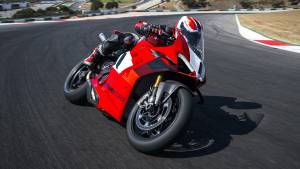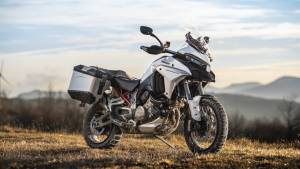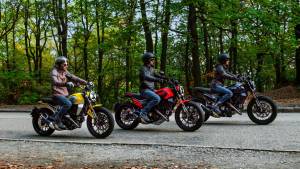All-new Ducati Panigale V4: What's inside?
The top of the range product from every company is a statement. Of intent. Of possibility. Of dreams made real. So it is with Ducati and their all-new Panigale V4. You have already seen the motorcycle most recently from our live coverage of the 2017 EICMA motorcycle show from Milan. Here are the top nine things you didn't know about Ducati's new V4.
The magnesium
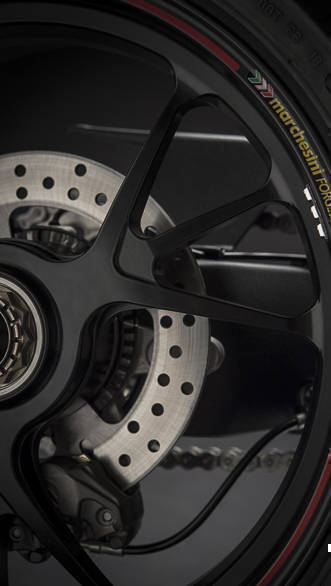
Light forged wheels and specially-made Pirelli Supercorsas hide the amount of electronics in play Panigale V4
All of the dull gold elements on the Panigale V4 are magnesium - sump, engine cases and both head covers. There's more in the front subframe, and on the Speciale, you can purchase magnesium wheels that save another kilo. Stefano Strappazon, chassis man, told OVERDRIVE only a few suppliers actually make these parts. That's why you only see it on exotic, expensive statement-level products.
Trellis gives way to aluminium
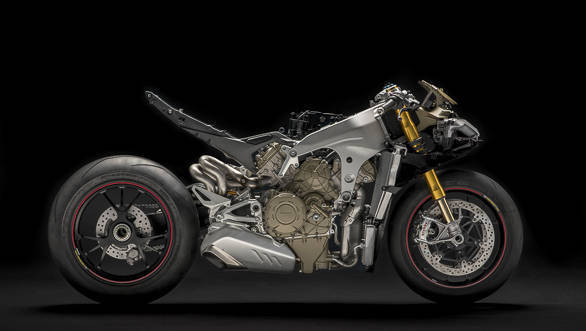 The matte gold/yellow ochre bits on the engine are all cast magnesium bits that help with keeping the motorcycle as light as possible
The matte gold/yellow ochre bits on the engine are all cast magnesium bits that help with keeping the motorcycle as light as possible
The V4's Front Frame is a 4kg aluminium casting with walls as thin as 3mm. A CFD-designed structure allows strength along the bike's length but controlled flex side-to-side. An equivalent steel trellis would be harder to make and heavier as well. Sometimes, engineering is just the easiest, least complex path to a solution.
No variable valves?
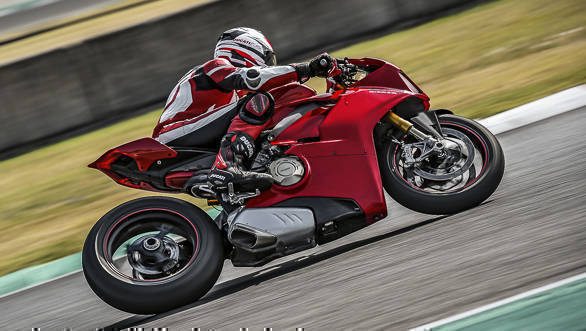
On the Multistrada, variable valve timing costs 5kg. On the V4 that's performance suicide. But Luca Bandiera, the engine designer, said why bother at all? Who will complain of a lack of torque at 3,000rpm on the V4 - he asks. He also points out that over 100Nm arrives at 7,000rpm and stays till almost 14,000rpm. So why add complexity?
The intake dance
Long intakes for torque and short ones for power. Or so we're told. The V4 uses this idea with its new variable intake trumpets. But between 9,500rpm and 12,500rpm it switches between configurations every 1,000rpm. Bandiera shrugs. "We ran the dyno with both configurations and selected the best intake position. The switch takes only 300 milliseconds." Why? The intake helps offset the pressure wave dynamics of the engine which could otherwise make for flat spots.
Event-based suspension system
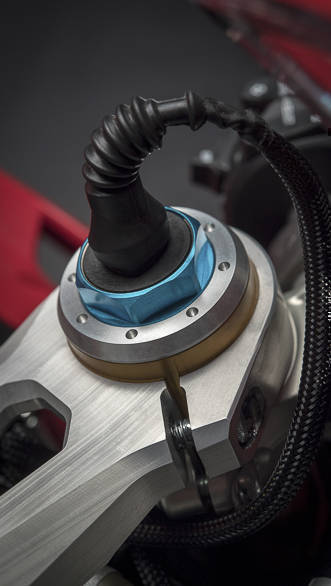 The Ohlins Smart EC 2.0 suspension is controlled electronically. It allows you to set parameters for turning, braking, exits and straight lines separately.
The Ohlins Smart EC 2.0 suspension is controlled electronically. It allows you to set parameters for turning, braking, exits and straight lines separately.
Cristiano Perboni, electronics man and Strappazon explain that on the S and Speciale, you can now set up each event - straight line, braking, turn-in etc. In the most ridiculous sounding -
but logical - way, you slide a cursor on a scale between performance and stability to select your setting.
Electronics: support not supplant skill
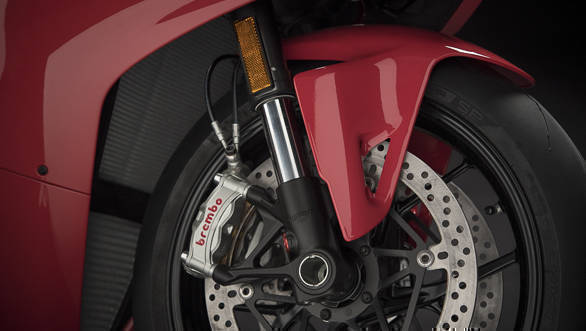 The Sachs upside-down forks on the Ducati V4 are fully adjustable
The Sachs upside-down forks on the Ducati V4 are fully adjustable
Strapazzon explained, "If you brake very hard as a habit, the Ohlins Smart EC 2.0 understands that pattern and can change the damping and suspension characteristics to support the style." In essence, Perboni's systems enable sliders to have more controlled slides with a safety net while Strappazon's systems alter the motorcycle's hardware to continuously support the way you ride.
The noise and the emissions impact
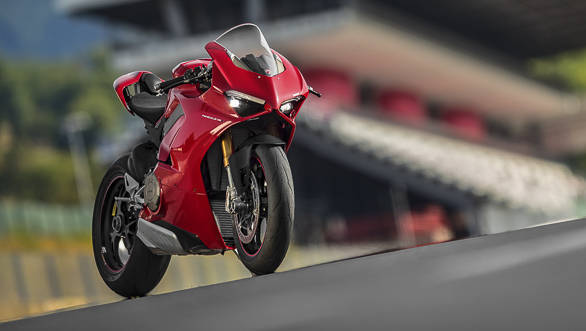
On the forward cylinder set, the silent cam chain drives the intake cam directly while on the other rear cylinder set, the chain drives the exhaust cams directly. Bandieraexplained that as a street-legal motorcycle, placing the cam chains on either side reduces the noise measurement for emissions purposes. "If you park this next to, say, the 1299, you immediately notice that the V4 seems to run quieter."
The Rider doesn't feel it
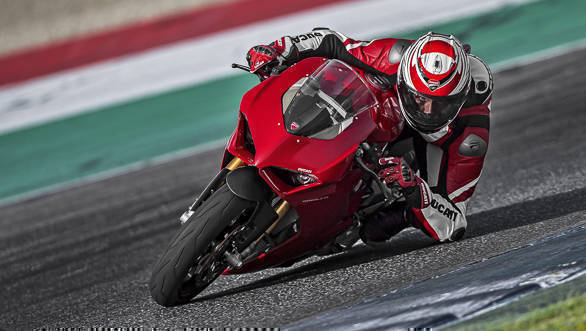
Bandiera let loose this terrific little one-liner. We were discussing the 'wobble' in the curve once torque plateaus between 9- and 11,000rpm. Bandiera smiled, "But the rider doesn't feel it." Ultimately, motorcycles are about giving the rider confidence. No matter what the curve looks like, to the V4's rider, he's just surfing a strong, predictable wave of torque.
Slip-based to torque-based
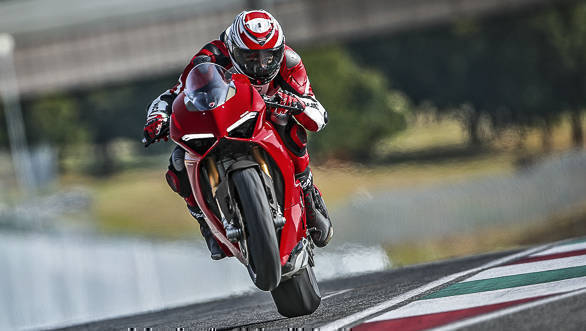
The BBS or Black Box as Ducati like to call it, makes decisions about all the chassis electronics based on sensors. But Perboni explains a subtle difference in the V4's algorithms and logic. Earlier, the system worked on detecting slip. Now, it is oriented towards torque flow. No one explained clearly - lost in translation perhaps - what the difference really is but I gathered from everyone that it changes the subtlety and controllability of the interference when the sensors, including the Bosch 6D IMU, detect the need to help or intervene.
Also read,
Ducati Desmosedici Stradale V4 engine unveiled
All-new Ducati Panigale V4: How it was made?
Starts Rs 15,30,000
1103cc
6-Speed
214.00
124.00
-NA-
Starts Rs 23,50,000
1103cc
6-Speed
214.00
124.00
-NA-
Related Stories
Top Stories
Latest Videos
Most Popular
- Upcoming Mahindra XUV 3XO: All you need to know
- New Suzuki Swift spotted testing
- Nissan Magnite EZ-Shift review - is the AMT any good?
- 2024 Hyundai Creta vs Toyota Urban Cruiser Hyryder vs Skoda Kushaq comparison review - the hype is real?
- Budget Sportbike Showdown: Kawasaki Ninja 500 vs Aprilia RS 457 vs Yamaha YZF-R3
